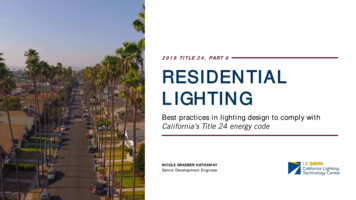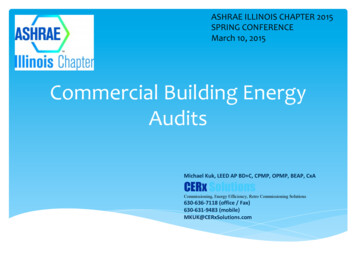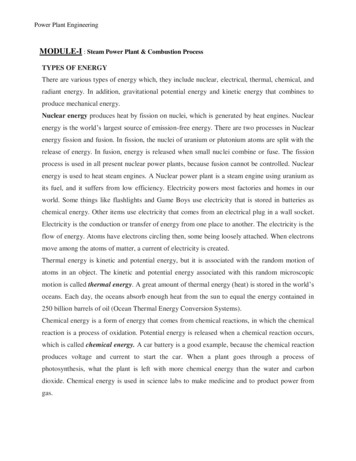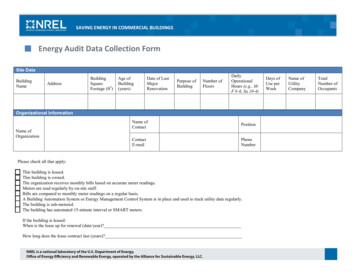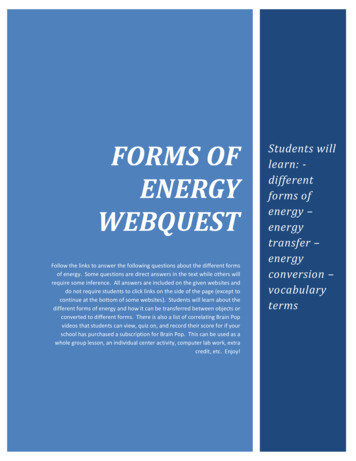
Transcription
? Integrated Resource Plan (IRP2019)OCTOBER 2019
Integrated Resource Plan (IRP2019)TABLE OF CONTENTSABBREVIATIONS AND ACRONYMS . 5GLOSSARY. 61.INTRODUCTION . 82.THE IRP IN CONTEXT. 102.1THE ENERGY MIX . 112.2ENVIRONMENTAL CONSIDERATIONS . 152.3PLANT RETIREMENTS DUE TO END-OF-LIFE. 152.4ELECTRICITY TARIFFS . 162.5WATER ENERGY NEXUS . 172.6ROLE OF ESKOM . 172.7MUNICIPALITIES AND RELATED ISSUES . 182.7.1Access . 182.7.2Non-Technical Losses and financial viability . 182.7.3Distributed Generation and Smart Grids. 192.8INVESTMENT TRENDS IN THE POWER SECTOR . 192.9REGIONAL INTEGRATION. 202.10RESEARCH AND DEVELOPMENT. 203.THE IRP PROCESS AND CONSULTATIONS . 214.INPUT PARAMETER ASSUMPTIONS . 244.1ELECTRICITY DEMAND . 244.1.1Electricity Demand from 2010–2016 . 244.1.2Electricity Demand Forecast for 2017–2050 . 274.1.3Impact of Embedded Generation, Energy Efficiency and Fuel Switching onDemand . 294.2TECHNOLOGY, FUEL AND EXTERNALITY COSTS . 304.2.1Economic Parameters . 314.2.2Technology Learning . 314.2.3Emissions Externality Costs . 324.3INSTALLED AND COMMITTED CAPACITY . 334.3.1Existing Eskom Plant Performance . 344.3.2Existing Eskom Plant Design Life . 344.3.3Compliance with Minimum Emissions Standards (Air Quality Regulations) . 36Page 1 of 98
Integrated Resource Plan (IRP2019)5.4.4CO2 EMISSION CONSTRAINTS . 364.5TRANSMISSION NETWORK COSTS . 37IRP UPDATE. 395.1OBSERVATIONS FROM THE TEST CASES . 405.2EMERGING LONG TERM PLAN (IRP 2019) . 425.3KEY CONSIDERATIONS AND SUPPORTING ACTIONS . 435.3.1 Immediate Term Security Supply . 435.3.2 Energy Mix and Just Transition . 445.3.3 Wind and PV . 465.3.4 Coal . 465.3.5 Gas to Power . 475.3.6 Nuclear . 475.3.7 Regional Power Projects . 485.3.8 Energy Storage . 495.3.9 Distributed Generation. 495.3.10 Risk Considerations . 506.APPENDICES . 536.1APPENDIX A – INSTALLED CAPACITY, MINISTERIAL DETERMINATIONS ANDDECOMISSIONING SCHEDULE . 536.1.1Municipal, Private and Eskom Generators . 536.1.2Eskom Generators . 546.1.3Emission Abatement Retrofit Programme and 50-year Life Decommissioning 556.1.4Projected Eskom Plant Energy Availability Factor . 556.2APPENDIX B – SUMMARY OF INPUT FROM PUBLIC SUBMISSIONS . 56A. POLICY &PROCESSES . 56B. DEMAND . 57C.MISSING TECHNOLOGIES . 59D. GENERAL. 60E. COAL . 61F. GAS . 65G. NUCLEAR . 68H. CSP . 71I. BATTERY STORAGE . 71J. EMBEDDED GENERATION/RENEWABLE ENERGY. 72Page 2 of 98
Integrated Resource Plan (IRP2019)K. HYDRO POWER . 74L.CLARITY COMMENTS . 746.3APPENDIX C – RESULTS OF TEST CASES . 796.4APPENDIX D – SUMMARY OF PUBLISHED DRAFT IRP 2018 . 866.4.1.INTRODUCTION . 866.4.2.RESULTS OF THE SCENARIOS . 876.4.3.CONCLUSIONS FROM ANALYSIS OF THE SCENARIOS. 916.4.4.DRAFT IRP 2018. 926.4.5.PUBLISHED DRAFT IRP 2018 ELECTRICITY TARIFF PATH COMPARISON96FiguresFigure 1: IRP Update Review Process . 22Figure 2: Expected GDP Growth from IRP 2010 vs Actual (Sources: Statistics SA &Promulgated IRP 2010–2030) . 25Figure 3: Expected Electricity Sent-out from IRP 2010–2030 vs Actual (Sources: Statistics SA& Promulgated IRP 2010–2030) . 25Figure 4: Electricity Intensity History 1990–2016 (Source: Own Calculations based onStatistics SA Data) . 26Figure 5: Expected Electricity Demand Forecast to 2050 . 27Figure 6: Technology Learning Rates . 32Figure 7: Cumulative Eskom Coal Generation Plants Decommissioning. 35Figure 8: Emission Reduction Trajectory (PPD). 37Figure 9: IRP 2019 Price Path . 43TablesTable 1: Published Draft IRP 2018 (Approved by Cabinet for Consultation) . 10Table 2: Local Emission and PM Costs . 32Table 3: CODs for Eskom New Build . 33Table 4: Test Case Variable Input Parameters . 39Table 5: IRP 2019 . 42Page 3 of 98
Integrated Resource Plan (IRP2019)ABBREVIATIONS AND ACRONYMSCCGEClosed Cycle Gas EngineCCGTClosed Cycle Gas TurbineCCSCarbon Capture and StorageCCUSCarbon Capture Utilization and StorageCO2Carbon DioxideCODCommercial Operation DateCOUECost of Unserved EnergyCSIRCouncil for Scientific and Industrial ResearchCSPConcentrating Solar PowerDEADepartment of Environmental AffairsDMREDepartment of Mineral Resources and EnergyDSMDemand Side ManagementEPRIElectric Power Research InstituteFGDFlue Gas DesulphurizationGDPGross Domestic ProductGHGGreenhouse GasICEInternal Combustion EngineGJGigajouleGWGigawatt (one thousand megawatts)HgMercuryHELEHigh Efficiency Low EmissionINDCIntended Nationally Determined ContributionIPPIndependent Power ProducerIRPIntegrated Resource PlankWKilowatt (one thousandth of a megawatt)kWhKilowatt hourPage 4 of 98
Integrated Resource Plan (IRP2019)kWpKilowatt-Peak (for Photo-voltaic options)LNGLiquefied Natural GasLPGLiquefied Petroleum GasMtMega tonMWMegawattNDPNational Development PlanNERSANational Energy Regulator of South Africa; alternatively the RegulatorNOxNitrogen OxidesOCGTOpen Cycle Gas TurbineO&MOperating and Maintenance (cost)PMParticulate MatterPPDPeak-Plateau-DeclinePPMPrice Path ModelPVPresent Value; alternatively Photo-voltaicRERenewable EnergyREIPPPRenewable Energy Independent Power Producers ProgrammeSADCSouthern African Development CommunitySOxSulphur OxidesTWTerawatt (one million megawatts)TWhTerawatt hourUNFCCCUnited Nations Framework Convention on Climate ChangeUCGUnderground Coal GasificationPage 5 of 98
Integrated Resource Plan (IRP2019)GLOSSARY“Capacity factor” refers to the expected output of the plant over a specific time period as aratio of the output if the plant operated at full-rated capacity for the same time period.“Collector Station” refers to the substation that connects various renewable energy generatingplants and or substations together in order to connect these plants to the Transmission network.“Cost of unserved energy (COUE)” refers to the opportunity cost to electricity consumers(and the economy) from electricity supply interruptions.“Demand side” refers to the demand for, or consumption of, electricity.“Demand side management (DSM)” refers to interventions to reduce energy consumption.“Discount rate” refers to the factor used in present value calculations that indicates the timevalue of money, thereby equating current and future costs.“Distributed generation” refers to small-scale technologies to produce electricity close to theend users of power.“Energy efficiency” refers to the effective use of energy to produce a given o
Integrated Resource Plan (IRP2019) Page 5 of 98 kWp Kilowatt-Peak (for Photo-voltaic options) LNG Liquefied Natural Gas LPG Liquefied Petroleum Gas




